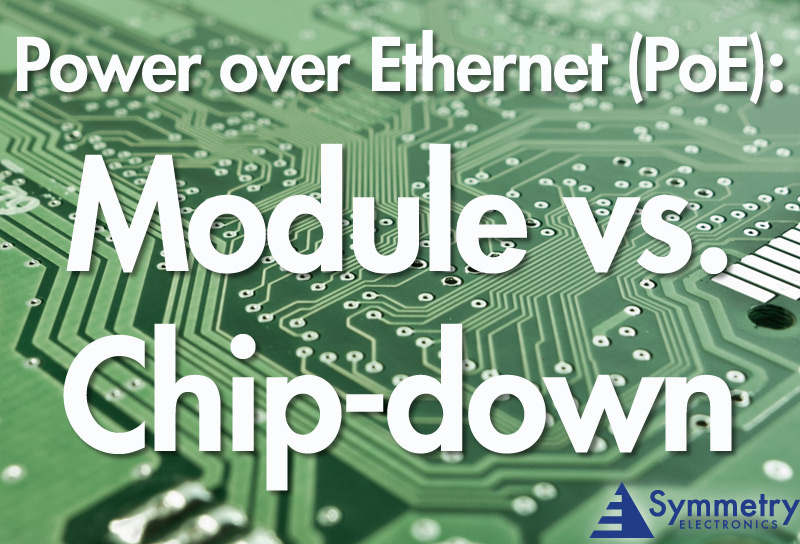- Home
- Symmetry Blog
- Power over Ethernet (PoE): Module vs Chip-down | Symmetry Blog
Power over Ethernet (PoE): Module vs Chip-down | Symmetry Blog
About Symmetry Electronics
Established in 1998, Symmetry Electronics, a Division of Braemac, is a global distributor of electronic components and systems. Combining premier components and comprehensive value-added services with an expert in-house engineering team, Symmetry supports engineers in the design, development, and deployment of a broad range of connected technologies.
Exponential Technology Group Member
Acquired by Berkshire Hathaway company TTI, Inc. in 2017, Symmetry Electronics is a proud Exponential Technology Group (XTG) member. A collection of specialty semiconductor distributors and engineering design firms, XTG stands alongside industry leaders TTI Inc., Mouser Electronics, and Sager Electronics. Together, we provide a united global supply chain solution with the shared mission of simplifying engineering, offering affordable technologies, and assisting engineers in accelerating time to market. For more information about XTG, visit www.xponentialgroup.com.

If you’re looking for a Power over Ethernet (PoE) solution, you want something effective, reliable and most of all, cost-efficient.
Engineers looking to add PoE eventually face an important question:
Should I use a module or a chip-down solution?
Sure, everyone wants to save money. If you buy the individual components and design the solution yourself, then the savings will add up over time, right?
But how many quantities will it take before it’s worth it? 50k? 100k? More?
What about the time spent on the design process? Or the amount of testing that needs to be done? And the certification process? Have you included the inventory, manufacturing and test time and cost?
Here are a few things to consider when choosing between a module and a chip-down solution:
Modules help you avoid obstacles
Before jumping ahead and purchasing a SoC, consider all the hurdles you must cross to create a successful chip-down design. The fact is, if your application will not be produced at very high quantities, a chip-down solution would not be worth it.
Even if you intend on having your product appeal to the mass market, if the design is a new concept and you don’t know how popular it will be, it would still be best to build using a module, and then transitioning to a SoC in later renditions once you know your product line has the demand to ensure success.
Modules help you stay efficient
To put it simply, for lower quantities of product, the design time involved is disproportionate to the value derived from doing the design yourselves. It would be much more favorable to use modules that have already gone through testing and design and are supported by a supplier’s applications team. If you take advantage of the schematic checks and application support provided by the supplier (which you should), design times are very low.
Avoid the “hidden costs” of chip-down design
There are a number of “hidden costs” that are associated with designing your own solution – when minimum component purchases (e.g. reels of ICs, transformers, resistors or capacitors) are taken into account, often the component cost and waste is far in excess of the module cost.
Modules, on the other hand, have been tested to work with all kinds of applications, including yours. Let those 2nd and 3rd PCB respins be a thing in the past. Modules are already EMC tested and compliant, saving you more time and frustration.
Lastly, no discrete-based design can get down to the footprint size of the smallest modules.
Take advantage of bulk pricing, even at low quantities
At lower quantities, the overall cost of using modules are often lower or at least similar to IC based design. How is this possible?
When a supplier produces large quantities of modules a year, they are able to lower the cost of production, and allowing customers of any quantity to take advantage of bulk pricing. Here, bulk purchasing and the economics of scalable manufacturing work in your favor.
For perspective, a chip-down solution requiring 10,000 quantities per year wouldn’t be able to bring transformer costs down to match the price of a module made at quantities of 200-300k per year.
So where do you find these high-quality, low-priced PoE modules?
The answer: Silvertel
Silvertel products are used by the biggest names in electronics because of their long-standing reliability and module quality. The customer base speaks for itself!
Reasons to use a Silvertel module:
- Saves PCB space.
- Easy to use, without requiring loads of extra components
- High-quality modules, guaranteed. All modules are made in the UK and are 100% tested by the manufacturer.
- Quicker time to market
- Excellent support from the applications team
- Saves Cost
Some of our recommended products include:
Silvertel Ag9700 for up to 12W
Silvertels’ Ag9700 series cost reduced PD modules are designed to extract power from a conventional twisted pair Category 5 Ethernet cable. These modules conform to the 802.3af Powerover-Ethernet (PoE) standard. This total solution includes 1.5kV isolation, PoE signature and integral DC to DC converter. The standard unit provides a Class 0 signature.
Silvertel Ag9900 for up to 12W
The Ag9900 series PD modules pushes the boundaries of POE miniaturisation further than ever before, yet still offers all the features expected from Silvertel’s POE. This is the smallest package size available that is designed to extract power from a Cat5 cable, fully conforming to the 802.3af Power-over-Ethernet (PoE) standard and includes 1.5kV isolation, PoE signature and an integral DC to DC converter. The module provides a Class 0 signature.
Silvertel Ag5300 for up to 30W
The Ag5300 series are low cost PoE+ modules, in a Single-In-Line (SIL) package, that can deliver up to 30 Watts of output power. Options for 12V DC (Ag5300) or 24V DC output (Ag5324) are available. The module signature complies with both the IEEE802.3af and IEEE802.3at specifications and it is designed to meet the safety isolation requirements of IEEE802.3at. The exceptionally small footprint and package size, make it ideal for space restricted applications such as IP Video Telephones, WiMAX access points, PTZ cameras and remote computer terminals. Ag5324 is well suited to building automation and industrial control applications requiring 24V with the ability of Ag5324 to operate over the industrial temperature range from -40 to +85C further extending its' versatility.
Silvertel Ag5800 (soon to be released) for up to 85W
Silvertels’ Ag5800 IEEE (draft) compliant PD module is designed for high power POE applications. Conforming to the latest IEEE802.3bt (Draft) Power-over-Ethernet (PoE) standard. Depending on cable length it can output up to 85W when supplied from an IEEE802.3bt PSE. This total solution includes 1.5kV of isolation, PoE signature and an integral DC to DC converter for 12 or 24V output.
See all PoE modules offered by Silvertel on the product page


